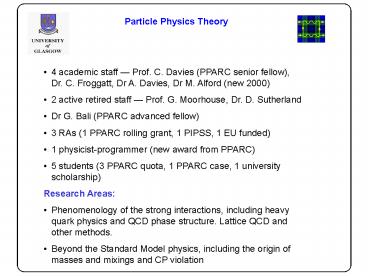Particle Physics Theory - PowerPoint PPT Presentation
Title:
Particle Physics Theory
Description:
1 physicist-programmer (new award from PPARC) ... Investigating QCD confinement. Potential between sources in representation D of SU(3) shows scaling with ... – PowerPoint PPT presentation
Number of Views:26
Avg rating:3.0/5.0
Title: Particle Physics Theory
1
Particle Physics Theory
- 4 academic staff Prof. C. Davies (PPARC senior
fellow), Dr. C. Froggatt, Dr A. Davies, Dr M.
Alford (new 2000) - 2 active retired staff Prof. G. Moorhouse, Dr.
D. Sutherland - Dr G. Bali (PPARC advanced fellow)
- 3 RAs (1 PPARC rolling grant, 1 PIPSS, 1 EU
funded) - 1 physicist-programmer (new award from PPARC)
- 5 students (3 PPARC quota, 1 PPARC case, 1
university scholarship) - Research Areas
- Phenomenology of the strong interactions,
including heavy quark physics and QCD phase
structure. Lattice QCD and other methods. - Beyond the Standard Model physics, including the
origin of masses and mixings and CP violation
2
Particle Physics Theory
Glasgow PPT and the world
- Co-ordinate 10-institution, 1.6 million euro EU
IHP network - Members of transatlantic HPQCD collaboration
- Members of GlasgowCopenhagenLjubljanaITEPTbili
si BSM collaboration - Members of UKQCD run 8-node Alpha cluster for
collaboration as part of QCDGRID, on PMC for
6.6M JIF-funded QCDOC project - Members of BSM and neutrino physics SPG
collaborations.
3
Particle Physics Theory
Current Funding PPARC rolling grant (4 year
spend) 189.4k PPARC PIPSS award (3
years) 129.7k EU network (3 years, Glasgow
share) 154keuro PPARC fellowships (senior
advanced) 318.1k PPARC HPC funding Alpha
cluster (3 years) 91.7k PPARC HPC funding
(3 years physicist-programmer) 135.4k BUSSTEPP
2002 PPARC funding 47.9k TOTAL
1,006.2k (plus studentships, Royal Society
travel awards etc)
4
Particle Physics Theory
Recent Physics Highlights
Lattice QCD
NRQCD formalism for b quarks in lattice QCD -gt
world-leading results on spectrum and decay
matrix elements of b hadrons.
(CD,S.Collins,M.Guertler) Aim reduce theoretical
uncertainties so that B factory experiments can
succeed in testing the Standard Model picture of
CP violation at the few level.
5
Particle Physics Theory
Key remaining problem including light dynamical
(sea) quarks in calculations. Numerically very
costly. We lead UKQCD programme to find best
method for QCDOC machine. Testing algorithms and
actions for improved staggered quarks.
(MA,CD,E.Follana)
With HPQCD collaboration we have Upsilon
physics on MILC configs including 21 flavours of
improved staggered quarks for first time.
Important spin-off determination of as-gt as(MZ)
0.117(3)(CD,A.Gray,RS) Test vs new CLEO results
will constrain b quark action for future
precision B physics.
6
Particle Physics Theory
Industrial spin-off
With BAE Systems, use large sparse matrix
techniques to calculate e.m. field around ships,
for reduction of magnetic signature from
corrosion currents and optimal placement of
radar. (CD, A. Watt (theory staff), E. Follana,
P. Allan (RS))
7
Particle Physics Theory
Investigating QCD confinement
Potential between sources in representation D of
SU(3) shows scaling with Casimir TrTaDTaD in
pure gauge theory. Provides constraint for models
of confinement mechanism, low energy QCD and
fragmentation. (GB)
8
Particle Physics Theory
Colour superconductivity
Compact (neutron) stars may reach high enough
internal density to have a core of quark matter
in the form of a colour superconductor. Key
point is what form quark Cooper pairs
take? Results for free energy show 3-flavor
pairing favoured over 2-flavour in bulk
equilibrium. (MA, plenary talk ICHEP02)
Signatures of quark pairing can arise from
effects on transport properties, e.g. viscosity,
and conductivity in star interior.
9
Particle Physics Theory
Pairings with different Lorentz structures have
different strengths. Quark matter in a neutron
star may involve several pairings including some
that break rotational invariance.
MA,G.Cowan(RS),J.Cheyne(RS)
10
Particle Physics Theory
Spontaneous CP violn in NMSSM
- SCPV possible at tree level. 2 Higgs doublets 1
singlet. - Phases on vevs lt 0.01 from EDM measurements
- Implies light CP-odd Higgs (lt 5 GeVxq/0.01)
- Hard to detect if dominantly singlet (decouples).
- CP even Higgs lt 130 GeV for LHC
AD,CF,A.Usai(RS),A.Tiesi(RS)
11
Particle Physics Theory
Grand Unified Theory with 4th generation?
- Possible to construct but very constrained. SUSY
required. - Heavy neutrino m 50 GeV. m(lepton)-m(neutrino)
lt 5 GeV. - Light SUSY particles. m(chargino,neutralino)
60GeV, m(b squark) 40 GeV (gt 4th sneutrino) - Light(ish) 4th generation quarks, m 100GeV.
- Tight tan b bounds (1.6-1.7)
CF,J.Dubicki(RS)
12
Particle Physics Theory
Strategy
- Wide range of activity with overlapping areas
- Variety of funding streams
- Focus on questions relevant to experiment
- Benefit from contact with PPE, AA and NP groups.
Future
- QCDOC machine (5-10 Tflops) will come on-line Q4
2003. Exploit this for maximum physics benefit. - Develop models of charged fermion and neutrino
masses consistent with SNO data, to be
constrained by further neutrino experiments.































